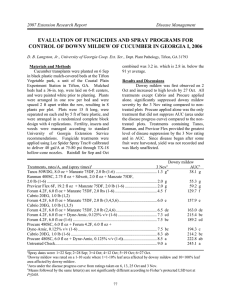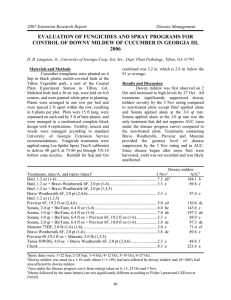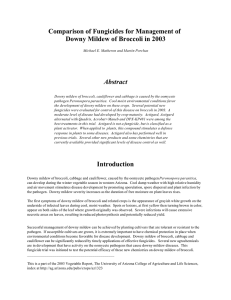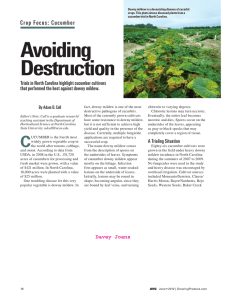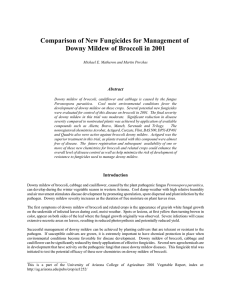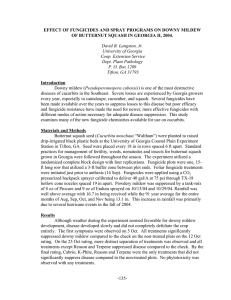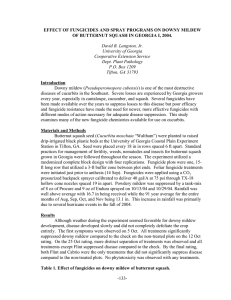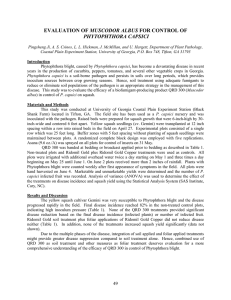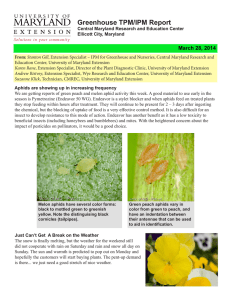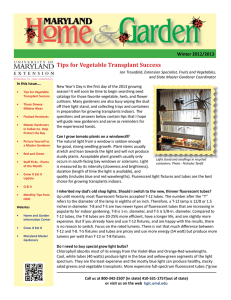EVALUATION OF FUNGICIDES TO SUPPRESS DOWNY MILDEW OF ZUCCHINI Plant Pathology
advertisement
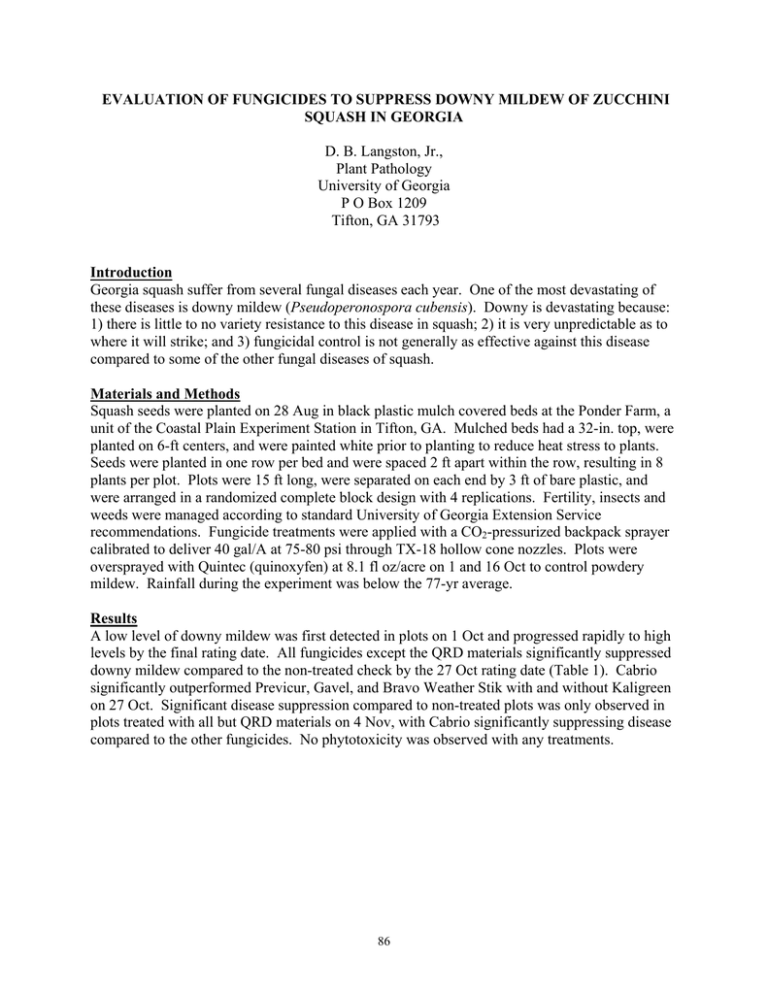
EVALUATION OF FUNGICIDES TO SUPPRESS DOWNY MILDEW OF ZUCCHINI SQUASH IN GEORGIA D. B. Langston, Jr., Plant Pathology University of Georgia P O Box 1209 Tifton, GA 31793 Introduction Georgia squash suffer from several fungal diseases each year. One of the most devastating of these diseases is downy mildew (Pseudoperonospora cubensis). Downy is devastating because: 1) there is little to no variety resistance to this disease in squash; 2) it is very unpredictable as to where it will strike; and 3) fungicidal control is not generally as effective against this disease compared to some of the other fungal diseases of squash. Materials and Methods Squash seeds were planted on 28 Aug in black plastic mulch covered beds at the Ponder Farm, a unit of the Coastal Plain Experiment Station in Tifton, GA. Mulched beds had a 32-in. top, were planted on 6-ft centers, and were painted white prior to planting to reduce heat stress to plants. Seeds were planted in one row per bed and were spaced 2 ft apart within the row, resulting in 8 plants per plot. Plots were 15 ft long, were separated on each end by 3 ft of bare plastic, and were arranged in a randomized complete block design with 4 replications. Fertility, insects and weeds were managed according to standard University of Georgia Extension Service recommendations. Fungicide treatments were applied with a CO2-pressurized backpack sprayer calibrated to deliver 40 gal/A at 75-80 psi through TX-18 hollow cone nozzles. Plots were oversprayed with Quintec (quinoxyfen) at 8.1 fl oz/acre on 1 and 16 Oct to control powdery mildew. Rainfall during the experiment was below the 77-yr average. Results A low level of downy mildew was first detected in plots on 1 Oct and progressed rapidly to high levels by the final rating date. All fungicides except the QRD materials significantly suppressed downy mildew compared to the non-treated check by the 27 Oct rating date (Table 1). Cabrio significantly outperformed Previcur, Gavel, and Bravo Weather Stik with and without Kaligreen on 27 Oct. Significant disease suppression compared to non-treated plots was only observed in plots treated with all but QRD materials on 4 Nov, with Cabrio significantly suppressing disease compared to the other fungicides. No phytotoxicity was observed with any treatments. 86 Table 1. Effect of fungicides on downy mildew severity. Downy mildewy 27 Oct 4 Nov Treatments, rates, and (spray times)z Cabrio 20EG, 12.0 oz/A (1-4)...................................................................2.1 cx 2.8 d Reason 500SC, 8.5 fl oz/A + Bond, 0.1% v/v (2, 4).................................3.5 bc 5.3 bc Previcur 724.5SC, 19.2 fl oz/A (1-4)........................................................4.3 b 5.3 bc Gavel 75DF, 2.0 lb/A (1-4).......................................................................4.5 b 4.5 c Bravo Weatherstik 720SC, 2.0 pt/A (1-4) ................................................4.6 b 6.0 b Kaligreen 82%, 2.5 lb/A + Bravo Weatherstik 720SC, 2.0 pt/A (1-4) ....4.5 b 5.3 bc QRD 137 WP 4.0 lb/100 gal (2, 4) ...........................................................7.5 a 9.5 a QRD 141 B9 WP, 2.3 lb/100 gal (2, 4).....................................................7.4 a 9.8 a QRD 131 AS, 1.0% v/v (2, 4)...................................................................7.8 a 9.3 a QRD 131 AS, 1.0% v/v + QRD 601, 0.125% w/w (2, 4) .........................7.8 a 9.5 a QRD 601, 0.125% w/w (2, 4) ...................................................................8.1 a 9.8 a Non-treated ...............................................................................................7.8 a 10.0 a z Spray dates were: 1=1 Oct; 2=8 Oct; 3=16 Oct; 4=24 Oct. Downy mildew was rated on a 1-10 scale where 1=1-10% leaf area affected by downy mildew and 10=100% leaf area affected by downy mildew. x Means followed by the same letter(s) are not significantly different according to Fisher’s protected LSD test at P≤0.05. y 87
